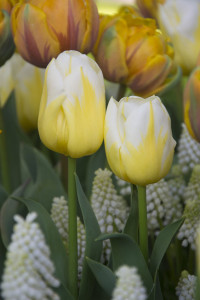 Have you ever been so consumed in your plans to expand an existing garden or build a new one that you started digging before you thought about what could have been under the ground? Just as you start to dig you find one of those little teardrop-shaped bulbs that have already spent their flowers in the spring or summer and were cut back to the ground weeks ago. With the many ways to mark plants in your garden, you won’t have to worry about slicing a perfectly good tulip bulb in two!
Have you ever been so consumed in your plans to expand an existing garden or build a new one that you started digging before you thought about what could have been under the ground? Just as you start to dig you find one of those little teardrop-shaped bulbs that have already spent their flowers in the spring or summer and were cut back to the ground weeks ago. With the many ways to mark plants in your garden, you won’t have to worry about slicing a perfectly good tulip bulb in two!
In your zest to get digging in your garden this summer, watch out for your azaleas, daffodils, hyacinths, lilies and tulips. Some of those creatures are already poking their green-tipped noses through the snow or moist soil. They might be easy to spot in the late spring, but after the leaves have turned yellow and you have cut the withering foliage back to the ground, there is no mark for their existence unless you have some ways to mark plants in your yard.
Best Location for Bulbs
Bulbs love the sun, or at least half of them do—the top halves. They tend to do best when their blossoms have sun and their roots are in the shade–shady feet and sunny tops. While most packages that you purchase will have instructions on how to plant your bulbs, some gardeners generally suggest planting your bulbs 3 inches below the surface and a foot apart.
Stakes Mark the Spot
After you put your bulbs below the surface, you might want to mark where your Easter blooms will appear and re-appear each year. Plant markers will keep you from destroying your bulbs that are at rest and markers will help you anticipate the return of those perennial blooms each year.
Artificial Cold
You may wonder if your tulips aren’t coming back because you really did slice them in two, but there are other reasons they may not have produced for you. Bulbs have to go through the seasons. They need very cold temperatures before they will bloom again. If you live in a warmer climate you may need to dig up your bulbs after the blossoms have faded and the green leaves have turned yellow and limp. You can take them inside and put them in a cooler. This transition will simulate some winter weather and provide some artificial cold. One month before you want your plant to bloom, you should take it out of the cooler. Then you’re ready to put it in the ground and mark it with a plant marker.
Kincaid Plant Markers can help you find ways to mark plants so that even in their off-season they are not forgotten. Whether you choose to print your labels or hand-write them, our stainless steel plant markers will guard your blooms for each season.
